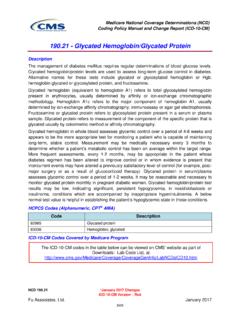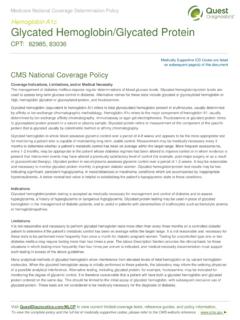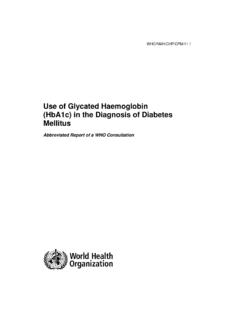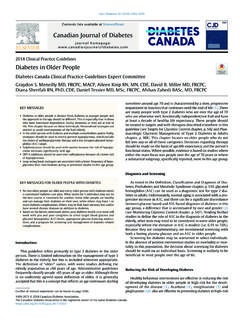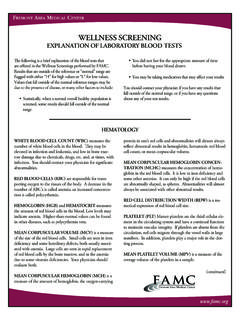Transcription of Three of 7 Hemoglobin A Point-of-Care Instruments …
1 Clinical Chemistry 60:8 Endocrinology and Metabolism 1062 1072 (2014). Three of 7 Hemoglobin A1c Point-of-Care Instruments Do Not meet generally accepted analytical performance criteria Erna Lenters-Westra1,2* and Robbert J. Slingerland1,2. BACKGROUND: In 2009, we investigated the confor- bias. Proficiency testing should be mandated for users mance of 8 Hemoglobin A1c (Hb A1c) Point-of-Care of Hb A1c POC assays to ensure quality. (POC) Instruments . Since then, Instruments have im- 2014 American Association for Clinical Chemistry proved and new devices are available on the market. In this second study, we evaluated the performance of DCA Vantage, Afinion, InnovaStar, Quo-Lab, Quo- Point-of-Care (POC)3 is the fastest growing market in Test, Cobas B101, and B-analyst Hb A1c POC clinical chemistry.
2 Today, there are some develop- Instruments . ments to transition diagnostics from the second line (in the hospital) to the first line (in the family physician's METHODS: Clinical and Laboratory Standards Institute office) or even to the zero line (in the patient's home). protocols EP-5 and EP-9 were applied to investigate (1 ). Ensuring the quality of the POC testing instru- imprecision, accuracy, and bias. We assessed bias using ment used is crucial and should be embedded in a chain the mean of 3 certified secondary reference measure- of quality control from hospital to doctors' offices; oth- ment procedures (SRMPs). Assay conformance with erwise the impact on patients will be immense, espe- the National Glycohemoglobin Standardization Pro- cially if these methods will be used for the diagnosis of gram (NGSP) certification criteria was also evaluated.
3 Different diseases. Interference of common Hb variants was investigated In 2009, we evaluated 8 different glycated hemo- for methods that could work with hemolysed material. globin (Hb A1c) POC Instruments and came to the conclusion that, at that time, 6 of 8 Hb A1c POC. RESULTS: The total CVs for all Instruments , except for Instruments did not meet the generally accepted an- the DCA Vantage at a high Hb A1c value, were alytical performance criteria of a total CV in SI units and in Diabetes Control and a National Glycohemoglobin Standardization and Complications Trial (DCCT) units. Afinion, Program (NGSP) manufacturer certification (2 4 ). DCA Vantage, B-analyst, and Cobas B101 instru- Since then, some manufacturers have either im- ments passed the NGSP criteria with 2 different re- proved their methods or withdrawn from the mar- agent lot numbers.
4 Quo-Test, Quo-Lab, and Innov- ket. New Instruments have since come to market. This initiated a second round of evaluations of dif- aStar Instruments had a negative bias compared to ferent POC Instruments . We approached all manu- the mean of the 3 SRMPs and failed NGSP criteria . facturers that joined the first evaluation study and Most of the common Hb variants did not interfere asked them if they were willing to join this second with the investigated Instruments , except Hb AE for round. Some were still improving their methods and the Cobas B101. not ready for this second test, and some did not want to join this second round for unknown reasons. In CONCLUSIONS: Afinion, DCA Vantage, Cobas B101, and the meantime, manufacturers from new POC instru- B-analyst Instruments met the generally accepted per- ments approached us and asked us to do an evalua- formance criteria for Hb A1c.
5 Quo-Test, Quo-Lab, and tion of their methods, and eventually we had 7 Hb InnovaStar met the criteria for precision but not for A1c POC Instruments to evaluate. 1. Department of Clinical Chemistry, Isala, Zwolle, the Netherlands; 2 European Previously published online at DOI: Reference Laboratory for Glycohemoglobin, Zwolle, the Netherlands. 2014 American Association for Clinical Chemistry 3. * Address correspondence to this author at: Isala, Department of Clinical Chem- Nonstandard abbreviations: POC, Point-of-Care ; Hb A1c, glycated Hemoglobin ;. istry, Dr. Van Heesweg 2, 8025 AB Zwolle, the Netherlands. Fax 31-38-4242- NGSP, National Glycohemoglobin Standardization Program; SRMP, secondary 676; e-mail reference measurement procedure; MDP, medical decision point; DCCT, Diabe- Received March 10, 2014; accepted May 15, 2014.
6 Tes Control and Complications Trial; RCV, reference change value. 1062. Evaluation of 7 Hb A1c Point-of-Care Instruments The aim of this study was to evaluate the 7 POC whole blood samples, n 24; 12 samples in duplicate). Instruments according to the CLSI protocols and to on Instruments specified for hemolysed material (6 ). check whether the Instruments would pass the NGSP For those not specified for hemolysed material, 12 fresh criteria with 2 different reagent lot numbers compared patient samples were run in duplicate. The familiariza- with 3 certified IFCC and NGSP secondary reference tion study was not done with the B-analyst. The values measurement procedures (SRMPs). Additionally, we were assigned to the IFCC monitoring samples by the investigated the presence of potential interference from IFCC network laboratories by use of the IFCC primary common Hb variants on the Instruments capable of reference methods (n 15) (7 ).
7 Values were assigned analyzing frozen material, and we tried to find out to the fresh patient samples by the 3 SRMPs mentioned whether the investigated Hb A1c POC Instruments can below. Precision was also calculated by analyzing the be used for the diagnosis of diabetes. samples in duplicate. The results were sent to the man- ufacturers for their approval to continue with the eval- Materials and Methods uation. After obtaining manufacturer approval, we used the CLSI EP-5 protocol to further investigate as- The 7 POC Hb A1canalyzers evaluated in this study say imprecision (duplicate measurements twice per were day on 2 patient samples for 20 days) (8 ). Aliquots were made from the patient samples and stored at minus The DCA Vantage (Siemens Medical Solutions Di- 80 C degrees until analysis.)
8 Controls supplied by the agnostics), which is based on latex agglutination in- manufacturer were used for Afinion and B-analyst, as hibition immunoassay methodology and provides these methods are not specified for use with hemolysed results in 6 min. material. Because B-analyst was evaluated 1 year ear- The B-analyst (Menarini Diagnostics), which is lier, we used a slightly different protocol for the impre- based on latex agglutination immunology turbidi- cision study. Aside from the controls supplied by the metric methodology, with results available in 8 min. manufacturer of the B-analyst (medium and high The Afinion (Alere Technologies), which is based value), we also used a fresh sample and analyzed it twice on boronate affinity separation, with results available per day in duplicate for 10 days instead of 20 days.
9 In 5 min. Studies in the past have shown that better CVs are The Quo-Test (Quotient Diagnostics, an EKF Diag- achieved with the Afinion when controls are used in an nostics Holding Company), which is based on boro- EP-5 protocol rather than patient samples (2, 4 ). nate affinity separation and the use of fluorescence Therefore CVs were also calculated on the basis of the quenching, with results available in 3 min. duplicates of the fresh patient samples in the EP-9 pro- The Quo-Lab (Quotient Diagnostics), which is based tocol for all Instruments . on boronate affinity separation and the use of fluo- The CLSI EP-9 protocol was performed twice with rescence quenching, with results available in 3 min 2 different reagent lot numbers, and the data were used (this method is the same as the Quo-Test but needs to investigate the bias between the POC Instruments some manual handling).
10 And the 3 SRMPs (n 40, 5 days, duplicate measure- The InnovaStar (DiaSys Diagnostics), which is based ments) (9 ). Hb A1c value determination of the patient on agglutination immunoassay and provides results samples was performed with 3 certified SRMPs: in 11 min. The Cobas B101 (Roche Diagnostics), which is Roche Tina-quant Hb A1c on Integra 800, based on latex agglutination inhibition immuno- immunoassay, IFCC and NGSP certified (Roche assay methodology and provides results in 5 min. Diagnostics);. Premier Hb9210, affinity chromatography HPLC, DCA Vantage, Afinion, Quo-Test, and InnovaStar IFCC and NGSP certified (Trinity Biotech); and analyzers were also evaluated in the previous study (2 ).

